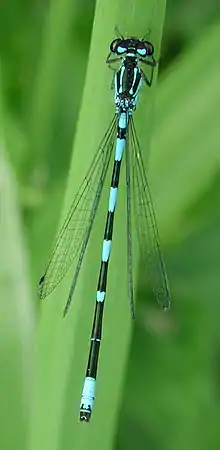| Coenagrion | |
|---|---|
 | |
| Coenagrion pulchellum | |
| Scientific classification | |
| Domain: | Eukaryota |
| Kingdom: | Animalia |
| Phylum: | Arthropoda |
| Class: | Insecta |
| Order: | Odonata |
| Suborder: | Zygoptera |
| Family: | Coenagrionidae |
| Genus: | Coenagrion Kirby, 1890[1] |
Coenagrion is a genus of damselflies in the family Coenagrionidae,[2] commonly called the Eurasian Bluets (although three species are found in North America: Coenagrion angulatum, Coenagrion interrogatum, and Coenagrion resolutum[3]). Species of Coenagrion are generally medium-sized, brightly coloured damselflies.[4]
Species
The genus Coenagrion includes the following species:[5][6][7]
- Coenagrion aculeatum Yu & Bu, 2007
- Coenagrion armatum (Charpentier, 1840) – Norfolk Damselfly[4] or Dark Bluet[8]
- Coenagrion angulatum Walker, 1912 – Prairie Bluet[9]
- Coenagrion australocaspicum Dumont & Heidari, 1996
- Coenagrion caerulescens (Fonscolombe, 1838) – Mediterranean Bluet[8]
- Coenagrion chusanicum Navás, 1933
- Coenagrion dorothaea Fourcroy, 1785
- Coenagrion ecornutum (Selys, 1872)
- Coenagrion exclamationis (Fraser, 1919)
- Coenagrion glaciale (Selys, 1872)
- Coenagrion hastulatum Charpentier, 1825 – Northern Damselfly,[4] Spearhead Bluet[8]
- Coenagrion holdereri (Förster, 1900)
- Coenagrion hylas (Trybom, 1889) – Siberian Bluet[8]
- Coenagrion intermedium Lohmann, 1990 – Cretan Bluet[8]
- Coenagrion interrogatum (Hagen in Selys, 1876) – Subarctic Bluet[9]
- Coenagrion johanssoni (Wallengren, 1894) – Arctic Bluet[8]
- Coenagrion lanceolatum (Selys, 1872)
- Coenagrion lunulatum (Charpentier, 1840) – Irish Damselfly,[4] Crescent Bluet[8]
- Coenagrion lyelli (Tillyard, 1913) – Swamp Bluet[10]
- Coenagrion melanoproctum (Selys, 1876)
- Coenagrion mercuriale (Charpentier, 1840) – Southern Damselfly,[4] Mercury Bluet[8]
- Coenagrion ornatum (Selys, 1850) – Ornate Bluet[8]
- Coenagrion persicum Lohmann, 1993
- Coenagrion ponticum (Bartenef, 1929)
- Coenagrion puella (Linnaeus, 1758) – Azure Damselfly[4]
- Coenagrion pulchellum (Van der Linden, 1823) – Variable Damselfly[4]
- Coenagrion resolutum (Hagen in Selys, 1876) – Taiga Bluet[9]
- Coenagrion scitulum (Rambur, 1842) – Dainty Damselfly,[4] Dainty Bluet[11]
- Coenagrion syriacum (Morton, 1924) – Syrian Bluet[12]
- Coenagrion terue (Asahina, 1949)
Biology
Thermal adaptation
This genus's capacity for phenotypically plastic responses to the surface air temperature is important to species' ranges.[13] These thermal responses will also decide a great deal of these species' responses to climate change.[13] Nilsson-Örtman et al., 2012 find a high degree of thermal adaptation in high latitude populations of Coenagrion.[13] They found similar plasticity even for various sympatric species at the same locations, and despite the highly variable weather at such latitudes.[13]
References
- ↑ Kirby, W.F. (1890). A Synonymic Catalogue of Neuroptera Odonata, or Dragonflies. With an Appendix of fossil species. London: Gurney & Jackson. pp. 202 [148]. doi:10.5962/bhl.title.5534.
- ↑ "Genus Coenagrion Kirby, 1890". Australian Faunal Directory. Australian Biological Resources Study. 2012. Retrieved 3 April 2017.
- ↑ Lam, Ed. Damselflies of the Northeast, Forest Hill:Biodiversity Press, 2004.
- 1 2 3 4 5 6 7 8 "Checklist of UK Species". British Dragonfly Society. Retrieved 5 August 2010.
- ↑ Coenagrion. funet.fi
- ↑ Zygoptera
- ↑ Paulson, D.; Schorr, M.; Abbott, J.; Bota-Sierra, C.; Deliry, C.; Dijkstra, K.-D.; Lozano, F. (2023). "World Odonata List". OdonataCentral, University of Alabama. Retrieved 14 Mar 2023.
- 1 2 3 4 5 6 7 8 9 "Checklist, English common names". DragonflyPix.com. Archived from the original on 4 December 2012. Retrieved 5 August 2010.
- 1 2 3 "North American Odonata". University of Puget Sound. 2009. Archived from the original on 11 July 2010. Retrieved 5 August 2010.
- ↑ Hawking, J. (2009). "Coenagrion lyelli". IUCN Red List of Threatened Species. 2009: e.T163530A5612194. doi:10.2305/IUCN.UK.2009-2.RLTS.T163530A5612194.en.
- ↑ "Dainty Bluet". dragonflypix.com. Archived from the original on 17 May 2008. Retrieved 19 October 2010.
- ↑ Schneider, W. & Kalkman, V. (2010). "Coenagrion syriacum". IUCN Red List of Threatened Species. 2010: e.T60272A12338268. doi:10.2305/IUCN.UK.2010-3.RLTS.T60272A12338268.en.
- 1 2 3 4 Sgrò, Carla M.; Terblanche, John S.; Hoffmann, Ary A. (2016-03-11). "What Can Plasticity Contribute to Insect Responses to Climate Change?". Annual Review of Entomology. Annual Reviews. 61 (1): 433–451. doi:10.1146/annurev-ento-010715-023859. ISSN 0066-4170.